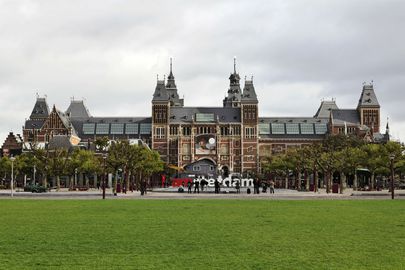

This part of town strives to be the pinnacle of sophistication as a home to three major museums: the Rijksmuseum, the Van Gogh Museum and the Stedelijk Museum of Modern Art, making this neighborhood the art lover’s paradise par excellence. Undoubtedly, culture vultures will be in their element in this recently renovated quarter.
The Museumplein is arguably the maincultural hub of the city, offering a wide range of activities and attractions. It caters to everyone, from children - in the form of a wading pool, to skateboarders - the half-pipe along the eastern edge, tourists - who love to climb the larger-than-life steel letters ‘IAMSTERDAM’, and the elderly - the benches and food stands close to the Rijksmuseum.
The Rijksmuseum - The State Museum - has been around for more than 200 years and is certainly one of the most impressive museums in the world. It was reopened in 2013 following a massive 10-year renovation and it remains the top tourist attraction in the country. The current building datesfromthe end of 19th century and was designed by PetrusCuypers. It was built in the then fashionable Dutch neo-Renaissance style, though it uses neo-Gothic elements and decoration. Undoubtedly, the Rijksmuseum's claim to fame lies in the fact it features such masterpieces of Dutch Golden Era painting as the Rembrandt’s Night Watch, several paintings by Vermeer and canvases by Frans Hals among many other Dutch masters. However the museum also has a truly exceptional collection of antique objects, a vast collection of prints, drawings and Classical photography.
The Van Gogh Museum maintains the world’s largest collection of works by this world’s most popular artist.It has over 200 of his paintings, more than 500 drawings and the famous letters to his brother Theo. The museum also features numerous works by Van Gogh's contemporaries. Each year, more than a million of art lovers tread the exhibition rooms of this museum, making it one of the most visited museums in the world. The main building, opened in 1973, was designed by GerritRietveld and completed by his partners after his death. The new futuristic elliptical exhibition wing by KishoKurokawa was opened in 1999. While this is certainly one of the most visited museums in the world, visiting off-season or on a Monday morning, one should be able to find a private moment with the 19th-century's greatest artistic genius.
The Stedelijk Museum - The Municipal Museumstrives to be one of the most innovative and interesting museums of modern art on the world scene. The museum reopened in 2012 following a complete renovation and a construction of a new wing that immediately acquired the nickname "The Bathtub", which it so unmistakably resembles. The Stedelijk is often the subject of controversy and criticism due to its artistic choice, its policy and financial decisions. For the connoisseur of modern and contemporary art, however, the Stedelijk is a must.
Established originally as the municipal museum, the Stedelijk became exclusively a modern art museum in 1975. It has a unique and much disputed collection of twenty-nine works by Kasimir Malevich, an equally exceptional collection of De Stijl and Cobra movements, a massive collection of Dutch photography and Dutch design. It, of course, also has works by such European and American giants as Matisse, Picasso, Newman, Rauschenberg and Warhol, as well as works of the Italian Arte Povera and contemporary German painting.
Flanking the Museumplein to the south is another gem of sophisticated Amsterdam culture, het Concertgebouw - the Concert Hall. The Concertgebouw is home to the famous Royal Concertgebouw Orchestra. In the early 1800s, architects fiercely competed for the right to build a proper concert hall in the district and the prize went to vanGendt. The Concertgebouw opened its doors in the end of 19th century and today it is internationally renowned for its immaculate acoustics and, locally, for its free lunchtime classical concerts.